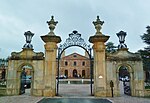Stony Brook Meeting House and Cemetery
Cemeteries in Mercer County, New JerseyChurches in Princeton, New JerseyHistoric district contributing properties in Mercer County, New JerseyHouses completed in 1726NRHP infobox with nocat ... and 2 more
Quaker meeting houses in New JerseyUse mdy dates from April 2012

Stony Brook Meeting House and Cemetery are historic Quaker sites located at the Stony Brook Settlement at the intersection of Princeton Pike/Mercer Road and Quaker Road in Princeton, New Jersey, United States. The first Europeans to settle in the Princeton area were six Quaker families who built their homes near the Stony Brook around 1696. In 1709 Benjamin Clark deeded nine and three-fifths acres in trust to Richard Stockton and others to establish a Friends meeting house and burial ground.
Excerpt from the Wikipedia article Stony Brook Meeting House and Cemetery (License: CC BY-SA 3.0, Authors, Images).Stony Brook Meeting House and Cemetery
Woodland Way,
Geographical coordinates (GPS) Address Nearby Places Show on map
Geographical coordinates (GPS)
| Latitude | Longitude |
|---|---|
| N 40.326888888889 ° | E -74.6775 ° |
Address
Woodland Way
08544
New Jersey, United States
Open on Google Maps









